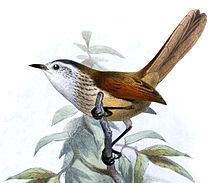Order Passeriformes Higher classification Synallaxis | Phylum Chordata Family Furnariidae Scientific name Synallaxis stictothorax Rank Species | |
 | ||
Similar Great spinetail, Dark‑breasted spinetail, Blackish‑headed spinetail, Chestnut‑throated spinetail, White‑bellied spinetail | ||
The necklaced spinetail (Synallaxis stictothorax) is a species of ovenbird in the family Furnariidae. Found in Ecuador and Peru, its natural habitat is subtropical or tropical dry shrubland.
Contents
The form Synallaxis (stictothorax) chinchipensis is sometimes split as a separate species, the Chinchipe spinetail.
Description
The necklaced spinetail is about 12.5 cm (5 in) long. The forehead is marked with black and white, and there is a white streak above the eye. The upper parts of the body, the wings and the tail are reddish brown. The flanks are buff and the tail feathers have blackish centres giving the tail a bicoloured effect. The throat and underparts are white, with some fine, dark, transverse streaks on the breast. The Chinchipe spinetail is slightly larger, with a buff superciliary streak, grey flanks, and a spotted rather than streaked breast.
Distribution and habitat
The necklaced spinetail is native to Ecuador and northern Peru. The Chinchipe spinetail inhabits the drainage of the Marañón River. The natural habitat of both is the borders of deciduous forest and arid scrub at altitudes of less than 300 metres (980 ft) above sea level.
Behaviour
The necklaced spinetail is more arboreal, rather bolder and more easily observed than most other members of its genus. The song is a distinctive series of sputtering notes, slowly descending and becoming less rapid and fading away at the conclusion. It is often sung from a perch near the bird's nest, or even from within this conspicuous structure which is globular, with a side entrance, and is made of sticks.
This bird feeds, often in pairs, on small invertebrates which it finds when foraging on the ground in the leaf litter or in the low branches of trees and shrubs.
Status
The necklaced spinetail is a fairly common bird within its rather restricted range. The total number of birds has not been estimated but the population trend seems to be stable so the International Union for Conservation of Nature has assessed its conservation status as being of "least concern".
